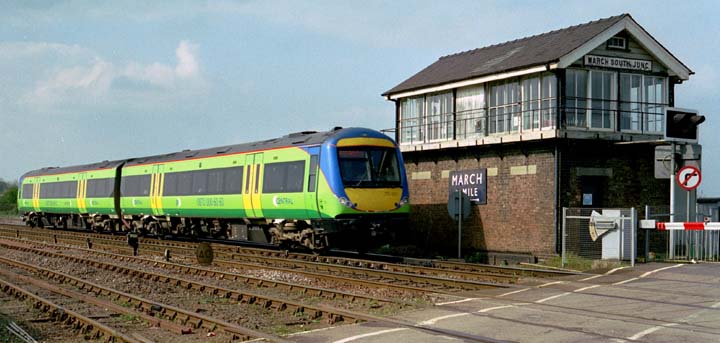www.ukrailways1970tilltoday.me.uk
Railways around Peterborough & The National Rail Network & Heritage railways in the UK
March Railways
 |
'March Railways About'
|
 |
Central Trains 2 car class 170 501 heading for Ely next to the March South Junc signal box in 2004.
About March and its railways
The railways in the town of March were the biggest employers after farming. March is in the flat fens, were farming on this reclaimed land was the main industry. The GER railway line ran from
Ely to March and
Peterborough. This is the line that is still open. There was a railway line from St Ives to March and one from
March to Spalding on the GN&GEJR . There was also a railway line from Wisbech (the track is still in place from March to Wisbech, but is not now joined to the main railway network. (This line may well be come a heritage line or may even be re-opened as a network rail line or is that just talk)
All these lines met up at March. These lines gave access to all East Anglia and the many small stations that had sidings for the local farmers and coal sidings for domestic coal, plus the all the bits and bobs that transported by wagon load by rail on the railways even up to the late 1950s. These wagons all needed sorting at March for the local pick up freights or to other yards in East Anglia or London.All this traffic was done by the wagon load or even just one box of apples. Each village would load its carrots or potatoes and strawberry and sugar beet in wagons depending on the time of year. Wagons of would then be collected by the local pick up freight ending up at the March yards. This meant these local freight trains would take all day with much shunting in the many wayside siding in the middle of nowhere. Often these pick up freights had to wait for passenger trains be for moving on to the next station or sidings just a few miles up the line.
Coal came from the East Midlands and Doncaster area, came though March on its way to London Cambridge and to the rest of East Anglia. These coal trains got longer with so many destinations together with the rest of the freight that the old railway yards at March could not cope.
Some thing had to be done, as it was sometimes taking weeks, to get wagons were they were supposed to be.Then all the empty coal wagons had to be returned back to the coal mines were they had come from. This was also made worst at harvest time with barley for Scotland and sugar beet and strawberry for London ect all needing wagons as well.
The flat empty Fen land was ideal for a Marshalling Yard and March Whitemoor was picked for a new large Marshalling yard. This opened on 3rd march 1929 on the site of an old yard on the Great Northern and Great Eastern Joint Railway line. There was just 24 sidings in the old yard. 1,265 Wagons was all these siding could hold. There was about 3,000 wagons a day going though these sidings. There were other siding in March but wagons had to be held as far away as Peterborough awaiting there turn to get to March. Trip working from yard to yard were also slowing things down.
The LNER Decided on a Hump Yard with Frohlich hydraulic brakes the first time they had been used in this country. This was for the up line with 43 sorting sidings were provided with room for 4,000 wagons for 350 desternations. In 1933 a down yard was added and by the start of the Second World War 8000 wagons could be sorted each day.
Trains were stopped at reception sidings the train engine removed, wagons were uncoupled and a cut card made out .This was taken to the control tower by pneumatic tube like the shops use to have. Then NE T1 4-8-0s pushed the wagons over the hump at 2mph (a speedometer was fitted on this engines to get the wright speed) the control tower setting the points the wagons being retarded by the right amount by the retarders. this depended on the number of wagons already in the siding. The wagons were supposed to stop or hit the wagons very slowly and shunter ran along side with a stick in these yards to put on the brakes and help this happen. More siding were added over the years and a large MPD was needed for all the engines for this traffic.
Class 37 light engine at the Whitemore Yard
In the 1960s line closures and station closures meant that the need for these large yards was no longer needed. On 27th January 1972 the down yard closed . The up yard taking its trains.
In 1982 the GN&GEJR from March to Spalding line was closed. The Departure sidings were now only used and what little traffic there still was transferred to Peterborough.
The Site of the main yard was closed and the track pulled up. Part of it is now the Whitemoor Prison. The MPD also gone and that left just just the one track to Wisbech. All the sidings that were at Whitemoor yard were removed.
Every one thought that the site would be sold for houses or factory units. But a home was needed for NetworkRail Distribution Centre then in London. When the site was needed for High Speed One. March was chosen as it had good links to the south east and west and was ready to start. March town council and Cambridgeshire County Council helped to get it though planing fast as it was still classed as a working railway yard.
A new
NetworkRail Distribution Centre has now been built on the southern part of the site of of The Old Whitemoor Yard. This was opened in 2004. Whitemoor Prison being on the northern part of what was once one of Europe biggest marshalling yards.
The Wisbech railway line is now not joined to the main network at March, but the track is still in place most of the way to Wisbech.
The Bramley Line Heritage Railway Trust is trying to reinstate the railway line between Wisbech and March as a Heritage Railway. Its Web site is at
http://www.bramleyline.org.uk/
Page updated 12/6/2020


